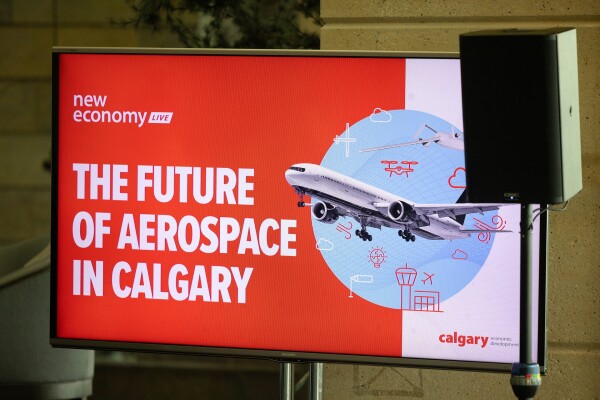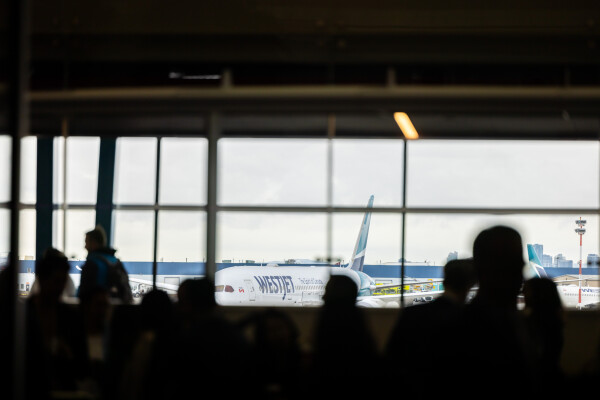Autonomous systems, machine learning and decarbonization are emerging as key trends in the future of aerospace – and Calgary’s aerospace sector is ready to embrace the possibilities.
At the most recent New Economy LIVE event, industry experts, a local futurist, researchers and more convened to explore how Calgary can seize the limitless opportunities that lie ahead in the sector’s future.
Building a city where emerging sectors like aerospace grow and Calgary companies accelerate and scale to compete globally is a priority in the community’s economic strategy.
What does the future of aerospace look like?
Unexpected possibilities lie ahead for aerospace and aviation in Calgary. 
The manager of foresight at Calgary Economic Development, Rachelle Bugeaud, delivered a presentation on the possible future developments for the aerospace and aviation sector in the short, medium and long-term.
Foresight – as she explained – helps build a comprehensive understanding of the industry’s possible trajectories and how to navigate the future with confidence.
“Foresight helps us figure out what we should do differently today. It helps us anticipate future talent demands, community needs and identify future fit businesses – and those businesses that have the potential be important in the future,” said Bugeaud.
“Part of being a futurist is to scour and monitor for change across industries to see what is possible. The future is going to happen, and you can control how you meet it – with foresight, excitement and being proactive by looking for change.”
The presentation, labelled Flight Path 2050, explored how we can draw insights on the future of aerospace by identifying emerging trends and potential disrupters that the industry might face.
These insights lead us to the exploration of future possibilities.
In the case of aerospace, Bugeaud analyzed global aerospace trends, including artificial intelligence, advanced engineering and manufacturing, super and hypersonic travel, urban air mobility, decarbonization and sustainability, commercialization of space, automation and robotics and digital linkages.
“The future of aerospace and aviation will be increasingly autonomous, data-informed, sustainable, distributed, diversified and efficient,” said Bugeaud.
“These emerging trends are risks and opportunities together. They mean different things to different people, and it’s up to us to decide how to action them as a community.”
Another emerging trend mentioned among panelists was the acceleration of sustainable aviation fuels (SAFs).
“Of all the places in Canada, Alberta has the tools to decarbonize and reduce emissions in aerospace rapidly – and the only way to make this work is if we work together,” said Geoffrey Tauvette, Executive Director, Canadian Council for Sustainable Aviation Fuels.
Innovation hub instrumental to growth of aerospace in Calgary
Calgary is emerging as a centre for innovation in aerospace, where entrepreneurs and visionaries can test and validate solutions and accelerate and scale their companies.

Earlier in 2024, the Opportunity Calgary Investment Fund (OCIF) announced an investment of $3.9 million over four years into the Aerospace Innovation Hub (AIH), where the event was held.
At the AIH, the city’s aerospace innovators gain access to funding, business support and the ability to validate their technologies in real-world settings.
The Aerospace Innovation Hub is one of the University of Calgary’s network of four themed innovation hubs managed by Innovate Calgary, including the Life Sciences Innovation Hub, the Energy Transition Centre and the Social Innovation Hub.
“Our vision is to make Calgary an aerospace hub that is nationally and internationally recognized. AIH provides an opportunity for large and small companies throughout Alberta to test items and scale to that next level,” said Kimberley Van Vliet, Director, Aerospace Innovation Hub.
Between 2024 and 2028, the AIH is expected to support incubator programming for up to 180 companies and create 150 net new skilled, indirect jobs. AIH will directly fund six companies through the accelerator program aimed at upskilling and attracting talent to the province.
“Calgary’s got great universities, relative affordability and a young, trained population. We have all the raw ingredients for the ecosystem to continue to grow – but we need ensure we have early-stage funding available for startups, so we can provide a good place to test their products,” said Chris Dinsdale, President and CEO, The Calgary Airport Authority.
Cities that push boundaries, encourage continuous learning and innovate can attract top talent for the growing sector, agreed panelists.
“As one of the highest-emitting industries, there has been less interest in aviation, but new, sustainable technologies will attract talent to consider aviation as a field to build a career in,” said Tauvette.
“Calgary has amazing, existing skilled talent that can be reskilled and upskilled into the aerospace industry,” said Hamid Rajani, Chair, at the Centre of Innovation and Research in Advance Manufacturing and Materials (CIRAMM) and Applied Research and Innovation Services (ARIS) at SAIT.
Collaborative ecosystem helps companies and talent succeed
Talent, companies and capital are looking to Calgary as a place they can succeed in aerospace, thanks to collaboration between industry and post-secondary institutions. In Calgary alone, there are more than 10 post-secondary programs offered in the sector.
The Southern Alberta Institute of Technology (SAIT) has rapidly expanded its focus on programs and opportunities in the industry – and in March 2024, SAIT was selected as a test centre for NATO’s Defence Innovation Accelerator for the North Atlantic (DIANA) network.
“Joining NATO was big news for SAIT. This brings the opportunity for international partnerships and visibility for Calgary’s aerospace sector on the global stage, while also helping to develop new tech in the city and province,” said Rajani.
The NATO DIANA test centre leverages Calgary’s thriving innovation ecosystem and tests deep tech with both civilian and military uses via access to NATO resources.
“No other province has two NATO defence test centres. With both SAIT and University of Alberta selected – there is a huge opportunity for us to work together with industry and government to propel the sector forward,” said Van Vliet.
Alberta’s aerospace and defence sector contributed $2.1 billion in GDP in 2022. DeHavilland Canada, Arcfield Canada, WestJet and Evans Consoles are among the aerospace and aviation companies that have found success in the city.
“It’s important that we provide a safe and secure environment where people can test new innovations. If it works, we have a competitive advantage, and if it doesn’t, we’ve done our best to try new technologies. We should never have a fear of failure,” said Dinsdale.
Calgary connects people and businesses globally
Beyond the development of new technologies, Calgary is home to one of the country’s busiest airports – welcoming over 18.5 million passengers in 2023.

The city is also headquarters to Canada’s second-largest airline, WestJet, which makes Calgary one of the best-connected mid-sized cities in North America.
“Having a robust aviation sector in Calgary is incredibly important for the economic opportunities it brings,” said Angela Avery, Executive Vice President and Chief People, Corporate & Sustainability Officer, WestJet.
“It’s our commitment to continue to grow, innovate and trial new technologies - to be your number one carrier to support this city, just like this city and province has always supported us.”
The airline selected Calgary as its sole global connecting hub in 2022, and the city now sees every 787 Dreamliner fly through its airport when on an international flight path.
With the blue sky the limit, Calgary’s aerospace sector is well-positioned for rapid growth and limitless opportunities.
